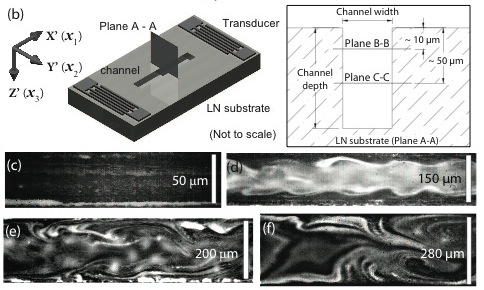358a Inducing Rapid Fluid Flows In Microchannels with Surface Wave Vibrations
The application of high-frequency (MHz-order) traveling wave vibrations along a microchannel cut into a piezoelectric substrate results in rapid fluid flows along the channel in the direction of the vibration propagation, up to 2 cm/s in a 50 x 100 micron rectangular channel in our device (b), believed to be faster than other methods known to the authors. The vibration energy carried along the sides and bottom of the channel is diffracted into the channel and imparts momentum to the fluid through a process commonly called streaming. Given the intended application area of most microfluidic devices---in biomedicine---the fluid would reasonably be expected to carry particles, and introducing micro and nanoparticles into the flow exposes transitions to chaotic behavior ( (c) to (d) ), particle collection, and rapid vortex formation and shedding ideal for mixing (e,f). We show experimentally what conditions are necessary for these transitions to appear, such as an increase in the channel width beyond a wavelength of the vibration radiation traveling along the channel walls. Furthermore we numerically solve the coupled piezoelectric solid-viscous fluid equations to determine the underlying vibration field propagating into the fluid from the solid, and show that the particle behavior is dependent upon both the irradiated vibration field on the particles themselves and the second-order streaming effects that arise in the fluid which move the particles via Stokes' drag. Taken together, the experimental and numerical analyses permit us to explain the peculiarities of the chosen system, such as particles traveling upstream from induced forces applied via standing waves formed across the channel during mixing, and transitions between steady and chaotic flow depending on the intensity of the traveling wave vibrations.

Web Page: mnrl.monash.edu.au